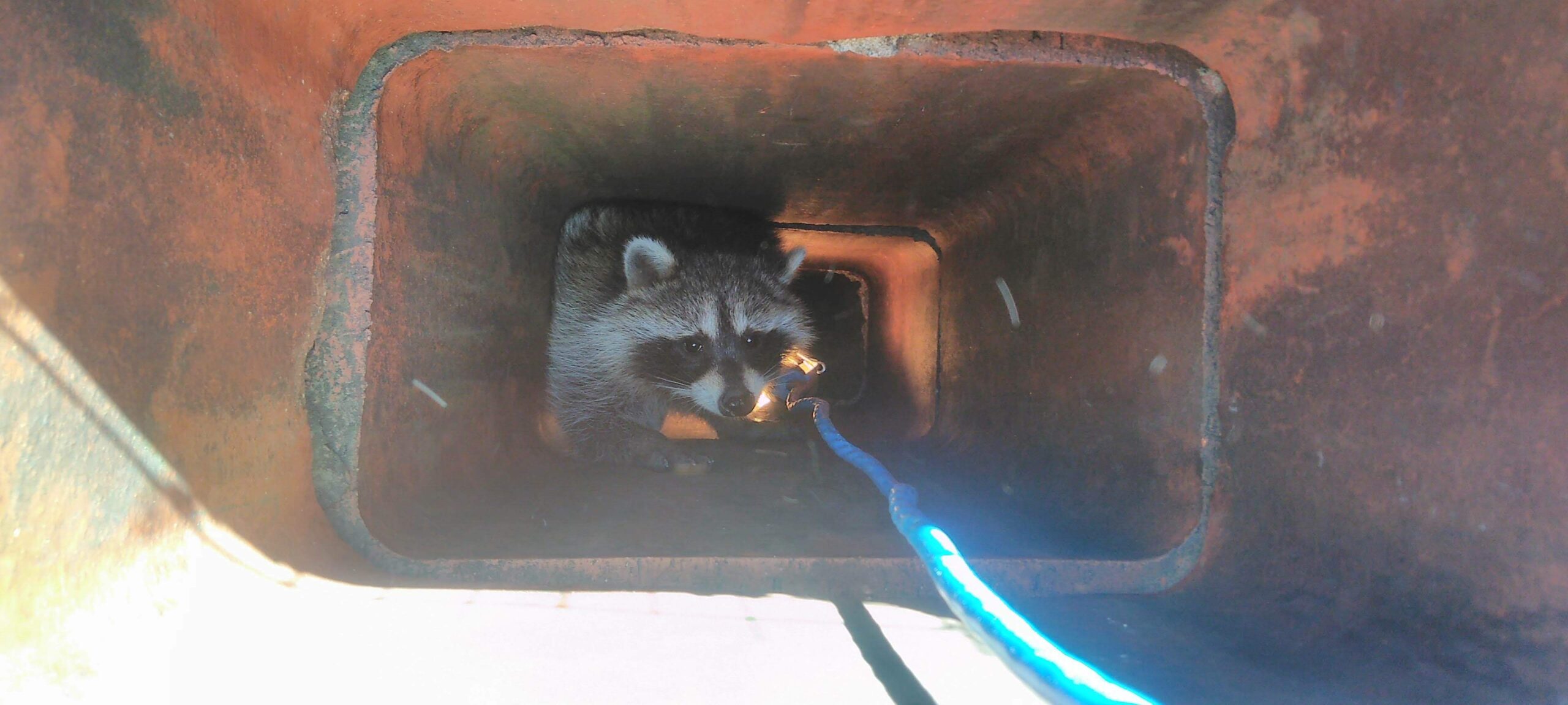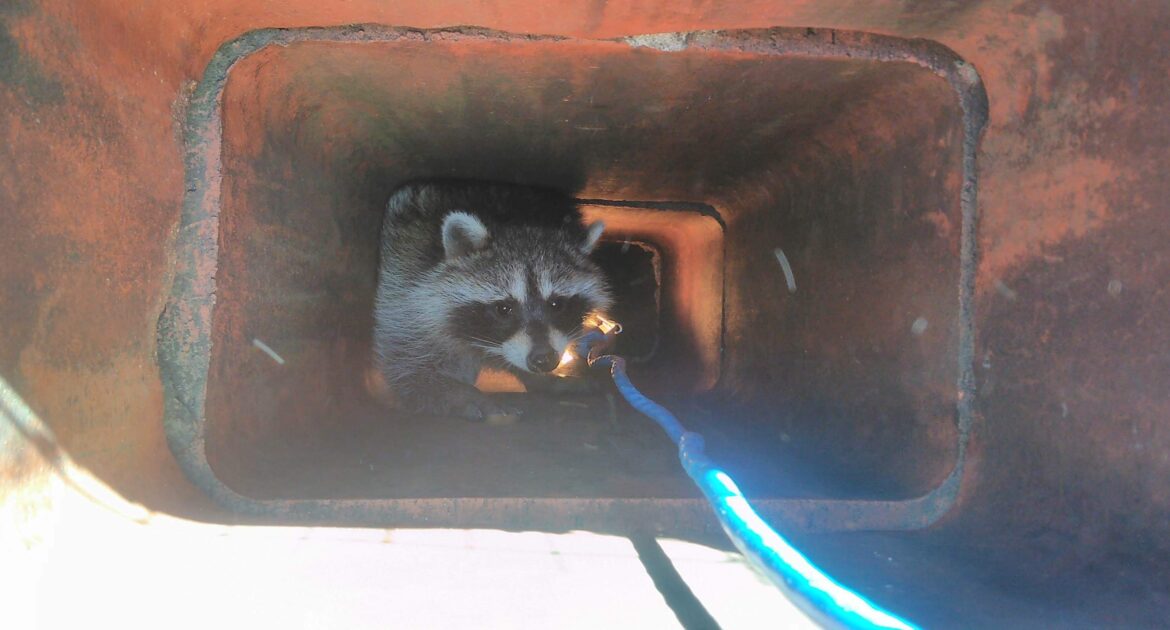Late nights in Atlanta are usually quiet, but if you hear scratching or chirping sounds in your home, you might have raccoons nesting in your chimney. These animals are drawn to chimneys because they mimic the hollow trees they use for shelter in the wild. High off the ground and protected from predators, chimneys provide a safe, warm space for raccoons to raise their young.
Spotting raccoons in chimneys is a common issue for Atlanta homeowners, and removing them requires care to ensure the safety of both your home and the animals. In this guide, we’ll explain why raccoons choose chimneys, how to recognize the signs of nesting, and why professional help—like our team at Skedaddle Humane Wildlife Control in Atlanta—is the best way to solve the problem. Let’s dive into how you can remove raccoons humanely and prevent them from returning.
Why Are Chimneys Appealing to Raccoons?
At first glance, you might wonder why a raccoon would willingly choose a chimney over natural spaces. But when you break it down, your chimney offers everything these animals could want when searching for a nesting spot. Here are a few reasons why:
Protection From Predators
Raccoons in the wild face threats from larger animals, including coyotes, owls, and even domestic pets. The top of a chimney, paired with its slender and secure structure, makes it nearly impossible for predators to follow. Climbing predators can’t easily maneuver the smooth brick or metal edges, leaving these animals safe inside.
This protection is crucial for mother raccoons caring for their young. It gives them a secure environment where they don’t need to worry about constant threats. For them, chimneys check all the boxes for a hidden and sturdy refuge.
Shelter From Weather
While Atlanta doesn’t often experience freezing winters, the unpredictable rainstorms and chilly nights that pop up in spring and fall can present challenges for these animals. Chimneys act as natural insulation, keeping the wind and rain out while maintaining a comfortably warm temperature within.
This warmth becomes even more critical when these animals are raising their babies. Newborn kits are delicate and require consistent shelter to survive. A chimney not only keeps them dry during sudden rain showers but also prevents drafts, making it a safe and cozy nest in all kinds of weather.
Perfect for Raising Kits
When it’s time to have babies, mother raccoons look for a nesting spot where their young will stay safe until they are big enough to venture out on their own. A chimney’s tall, enclosed design gives the mother peace of mind knowing her kits are well-protected from predators and human activity.
Additionally, the vertical design makes it harder for predators to reach or even spot the nest. The height of the chimney also offers a clear view of her surroundings, which lets the mother keep an eye out for any potential threats while still inside the comfort of her chosen shelter.
Easy Accessibility
Raccoons are remarkably good at climbing. They can effortlessly ascend fences, trees, and even house walls when there’s a reward waiting, like food or a safe nesting spot. Chimneys that sit close to trees or other tall structures are particularly inviting because the raccoons can use these as launch points to reach the top.
Once they make it to the edge, entering the chimney is straightforward, especially if there’s no cap blocking the way. Even chimneys that seem hard to reach are no match for a determined raccoon, as their balance and climbing strength are unmatched for their size.
Quiet and Solitary
Unlike busy parts of the home, like the kitchen or living room, chimneys are tucked away, providing raccoons with the undisturbed environments they instinctively seek. For these animals, avoiding noise and movement is key to feeling safe. The less activity they sense around their nesting site, the more likely they are to settle in.
Chimneys, especially those in homes without active fireplaces, can go weeks or even months without any disruption. This makes them a prime choice for raccoons. Their natural instincts are to avoid human activity altogether, and a rarely used chimney provides the perfect mix of seclusion and security.
How to Know If Raccoons Are in Your Chimney
Raccoons don’t always make their presence known right away. Here are some warning signs that they may have settled into your chimney:
- Unusual Sounds: Noises like scratching, shuffling, or even high-pitched chirps are clear indicators of raccoons. These sounds might be more noticeable at night since raccoons are nocturnal.
- Lingering Odors: Raccoons leave waste where they nest, creating strong, unpleasant smell over time. This can spread from the chimney to other parts of your home.
- Damage Around the Chimney Area: Claw marks, scratches, or evidence of chewing near the chimney opening could signal raccoon activity.
- Sightings Nearby: If you see raccoons on your roof or near the base of your chimney, it’s worth inspecting to make sure they haven’t gotten inside.
Why You Shouldn’t Ignore Raccoons in Chimneys
Having raccoons in chimneys can lead to serious problems that go beyond just being a nuisance. One major risk is the fire hazard they create. Raccoons often drag twigs, leaves, and other materials into chimneys to build their nests. These items are highly flammable, and if a fire is lit below, it could ignite the nest and cause dangerous chimney fires that threaten your home.
Structural damage is another concern. Raccoons are strong animals with sharp claws, and they can scratch up chimney liners, rip apart insulation, and even damage your roof while climbing up and down. Over time, these issues can add up to costly repairs that disrupt your peace of mind and strain your budget.
Health risks make the presence of raccoons even more alarming. These animals can carry diseases like leptospirosis and rabies, which are dangerous to both humans and pets. Additionally, their droppings can harbor harmful bacteria and parasites, increasing the risk of illness for your household. Exposure to these waste materials, even indirectly, can pose a danger to your family’s health.
Another serious issue caused by raccoons in chimneys is blocked ventilation. The nests they build can obstruct airflow, reducing the chimney’s ability to vent smoke and gases properly. This could lead to dangerous smoke or even carbon monoxide accumulating in your home, creating significant safety hazards.
With risks ranging from fires and expensive damage to serious health threats, it’s clear that the presence of raccoons can’t be ignored. Addressing the problem as soon as possible helps protect your home and keeps your family safe.
The Right Way to Remove Raccoons From Chimneys
Attempting to handle raccoons on your own is never a good idea. Raccoons are strong, unpredictable, and protective of their kits. Approaching them could provoke aggression or cause harm to the animals. That’s why it’s best to leave chimney raccoon removal to professionals who specialize in humane methods.
At Skedaddle Humane Wildlife Control in Atlanta, we follow a proven, humane process that prioritizes the safety of both raccoons and homeowners. Here’s how we handle the situation:
- One-Way Doors: We install specially designed one-way doors on the chimney. These devices allow raccoons to leave on their own but prevent them from returning.
- Thorough Inspection and Cleanup: Once the raccoons are gone, we inspect the area to identify and remove any nesting materials or waste. We also sanitize the space to eliminate odors and bacteria.
- Preventative Measures: Our team works to seal entry points and install durable chimney caps to keep raccoons from returning in the future.
Steps to Prevent Raccoons From Coming Back
After raccoon removal, it’s essential to take steps to ensure they don’t return. Here’s how to make your home less appealing to raccoons:
- Install a Chimney Cap: A simple chimney cap can block raccoons while still allowing smoke to escape. It’s one of the best defenses against raccoon nesting.
- Trim Overhanging Branches: Tree branches close to your roof can act as a ladder for raccoons. Regularly trimming these branches reduces access points.
- Secure Trash and Food: Garbage cans and pet food left outside are easy targets for raccoons. Use tight-fitting lids and avoid leaving food outdoors overnight.
- Inspect Regularly: Keep an eye on your roof and chimney for any holes, gaps, or signs of tampering. Addressing these promptly can prevent re-entry.
Take Back Your Chimney Today!
If you’re dealing with raccoons in chimneys, don’t wait for the problem to grow. At Skedaddle Humane Wildlife Control in Atlanta, we specialize in effective, humane removal that protects both your home and the animals. With our one-way door solutions and prevention strategies, we’ll help you reclaim both your chimney and your peace of mind.
Reach out to us today for an estimate and see how we can help make your chimney raccoon-free for good. Time to show those raccoons the way out!




